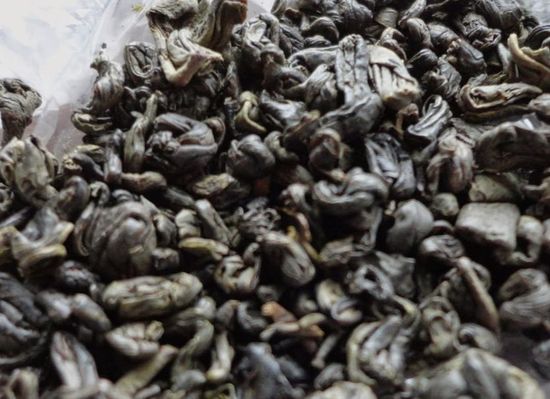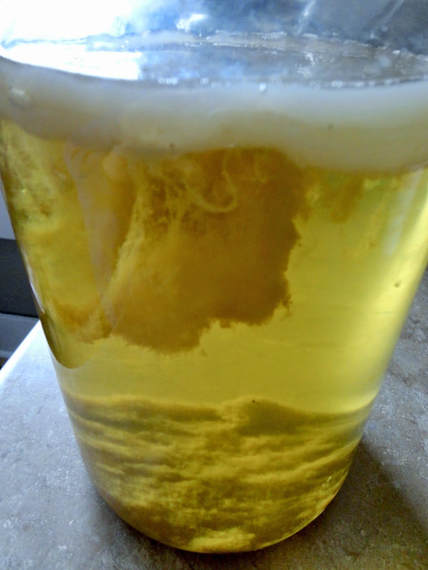|
You may be well-acquainted with kombucha, the fermented tea drink that has been sweeping the nation for the past few years. It is nearly impossible to go to a health food store or even a conventional grocery store, without spotting at least one brand of kombucha. For those unfamiliar, kombucha is a non-alcoholic fermented beverage made with black tea and cane sugar, which is fermented with a SCOBY (symbiotic colony of bacteria and yeast) and enjoyed for its positive health benefits. People especially flock to it because of certain bacteria, enzymes and organic acids, making it a wonderful tonic to aid in digestion and boost immune function. While you might have heard of kombucha, there is a similar but lesser-known tonic made by fermentation with a SCOBY, but with slightly different ingredients. That's right: kombucha has a cool cousin, and it's called Jun. Instead of black tea, jun is made with green tea, and is sweetened with honey instead of cane sugar. This gives it a milder flavor, with a slightly floral taste compared to its kombucha counterpart. It also has a different make up of bacteria and yeasts, so it is a great thing to incorporate if you are working on increasing the diversity of fermented foods into your diet to improve your microbiome. It is important to use raw, unprocessed honey in your jun, as it is full of naturally-occurring vitamins and enzymes, and will enhance the nutritional value of your tea. Also, processed honey may not be pure, 100% honey. Some commercial supermarket "honey" can be cut with high fructose corn syrup without being labeled as such. So, as always, local, unprocessed raw honey is the best choice. According to the Kombucha Kamp website (a mecca for all things kombucha), jun thrives at a slightly lower temperature than the warm-loving kombucha, 68-77 F instead of 78-85 F. This makes jun a wonderful beverage to brew in the colder months, as your kitchen is likely quite a bit cooler now than in the summer months--I know mine is! This can also be nice in the summer if your kitchen is air conditioned and stays a little cooler. For this, I envy you. Jun can turn out to be quite fizzy, so this is a nice drink to have instead of pop or alcohol. To obtain a mother culture to make your own jun at home, you can try to find a friend or someone in your community who is already brewing some, or you can purchase a SCOBY on websites like Kombucha Kamp that will ship them to you along with some starter liquid to get things going. A small investment up front, but it is delicious and totally worth it. You can also check out this post from the Nourished Kitchen and this article by Kombucha Brooklyn for more on the history of jun tea and more fun tidbits! Continuous Brew Jun Tea
Makes 1 gallon 1 jun SCOBY (aka "mother" or starter culture), see above link for a good source 1 cup prepared jun, for the starter liquid 4 tsp loose leaf green tea-- use a good quality tea here! 3/4 cup raw honey, local if possible 1 gallon filtered water Flavorings for the second ferment: ~3/4 cup organic juice or fruit puree or ~1/4 cup herbs or fresh ginger (rose hips and elderberries are nice!) Bring 1 quart of the water to a boil. Remove from the heat and add the loose leaf green tea. Cover and let brew for 4-6 minutes. Be careful not to let sit too long or it can become bitter. While the tea is steeping, add the raw honey to a gallon-sized glass jar. You can use one with a spout for easier dispensing, but any glass jar will do. Once steeped, strain the tea into the jar with the honey. Stir well to dissolve the honey and combine with the tea. Add the rest of the filtered water and fill almost to the top, leaving a few inches of space for the SCOBY and starter liquid. When the tea is cooled to room temperature, add the SCOBY and the jun starter liquid. Cover the jar with a cloth to keep out dust and bugs, then secure in place with a rubber band or string. Let the jun sit for 3-5 days for the first phase of fermentation. This is fewer days than with kombucha, as these cultures tend to ferment more quickly. You will see strands of yeast forming and all sorts of fun stuff growing in the jun, and it is beautiful! To prepare for the second fermentation, remove the SCOBY. and set aside. Take out 1 cup of prepared jun as the starter for your next batch--it's continuous! If a second SCOBY has formed, you can remove that, along with another cup of fermented jun, and place them in a jar to give away or start another gallon on jun. If it hasn't just take out the one cup of jun and proceed to the second fermentation. At this point, you would start your next batch of jun tea to replace what you will be decanting into the bottles, starting the whole process over. Thus, the continuous brew method. For the second fermentation: Prepare approximately 6 bottles for filling; I use 16 oz. flip-top amber glass bottles, but you could also use leftover kombucha bottles. Add flavorings to your liking, or omit for a simple jun tea. My favorite jun flavor additions are organic grape juice, lemon/ginger, rose hip/elderberry and pureed berries. Divide the juice, fruit or other herbal flavorings amongst the bottles evenly, using about 2 Tbs juice or puree, or 1-2 tsp herbs, per bottle. Dispense the prepared jun into the bottles, filling almost to the top. Add the caps or swing tops to close. Let sit 2-3 more days to allow for carbonation. Transfer to the refrigerator until ready to serve. Once you grow some new jun SCOBYs of your own, be sure to give them to friends so they can make their own home brews and spread the deliciousness of jun tea!
0 Comments
Leave a Reply. |
Brine & Broth
I am a gut health-focused nutritionist and online health coach based in Southwest Wisconsin. My recipes and philosophies center around traditional, nutrient-dense foods that support robust gut health. Archives
May 2022
Categories |






 RSS Feed
RSS Feed
